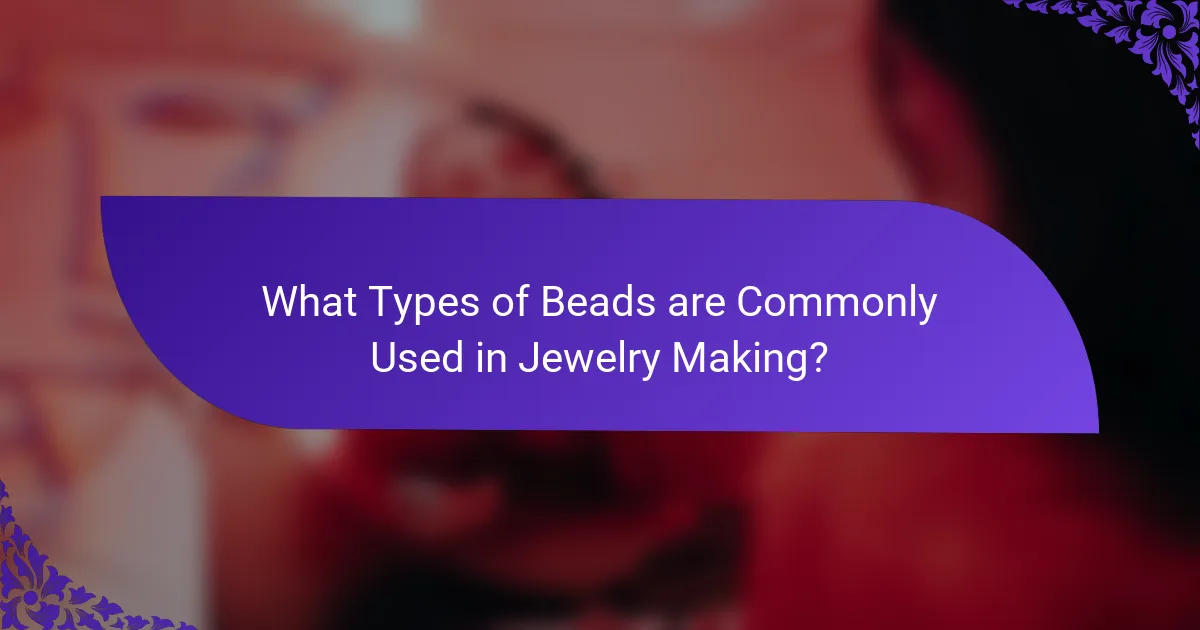Beads are small decorative objects essential for jewelry creation, made from materials such as glass, wood, metal, and gemstones. They serve both functional and aesthetic roles, enhancing designs with color, texture, and visual interest. This article explores the various types of beads commonly used in jewelry making, including their unique properties and applications. It also discusses the different materials used to create beads, highlighting their significance in crafting necklaces, bracelets, and earrings. Understanding these elements is crucial for anyone interested in jewelry design and personal expression through adornment.

What are Beads and Their Importance in Jewelry Creation?
Beads are small decorative objects used in jewelry creation. They can be made from various materials, including glass, wood, metal, and gemstones. Beads serve both functional and aesthetic purposes in jewelry. They add color, texture, and visual interest to designs. Beads can be strung together or sewn onto fabric, allowing for diverse applications. The use of beads dates back thousands of years, indicating their long-standing significance in adornment. They are essential for creating necklaces, bracelets, and earrings. The variety of bead types enables unique styles and personal expression in jewelry design.
How do Beads Enhance Jewelry Design?
Beads enhance jewelry design by adding color, texture, and visual interest. They serve as focal points in various styles of jewelry. Beads come in numerous materials, including glass, wood, and metal. This variety allows for creative expression and customization. The size and shape of beads can influence the overall design aesthetic. Larger beads may create bold statements, while smaller beads can add subtle elegance. Beads also enable the incorporation of patterns and motifs, enriching the narrative of the piece. Historical use of beads in jewelry dates back thousands of years, demonstrating their enduring appeal and versatility.
What Aesthetic Qualities do Beads Contribute?
Beads contribute various aesthetic qualities to jewelry, enhancing visual appeal and texture. They come in diverse shapes, sizes, and colors, allowing for creative expression. The reflective surfaces of beads can create eye-catching light effects. Their arrangement can lead to unique patterns and designs. Beads can also add depth and dimension to pieces. Furthermore, the materials used, such as glass, wood, or metal, influence the overall aesthetic. Historical significance can also enhance their visual storytelling. Collectively, these qualities make beads essential in jewelry design.
How do Beads Influence the Overall Style of Jewelry?
Beads significantly influence the overall style of jewelry by adding texture, color, and visual interest. They can transform a simple design into a statement piece. The variety of materials used, such as glass, wood, or gemstones, contributes to diverse aesthetics. Beads can also dictate the formality of jewelry. For example, bright plastic beads create a casual look, while pearls offer elegance. Additionally, the arrangement of beads affects the flow and structure of the piece. This versatility allows designers to cater to different tastes and occasions. Historical trends show that bead styles evolve, impacting fashion cycles and personal expression.
Why are Beads Considered Versatile Components in Jewelry?
Beads are considered versatile components in jewelry due to their diverse shapes, sizes, and materials. They can be made from glass, wood, metal, or stone, offering a wide range of aesthetic options. Beads can serve various functions, such as focal points or accents in a piece. Their adaptability allows for different design techniques, including stringing, weaving, and embroidery.
Historically, beads have been used in various cultures for adornment and symbolic purposes. For example, ancient Egyptians utilized glass beads in their jewelry to signify status. Additionally, beads can easily be combined with other components like chains or wires, enhancing their functionality. The ability to customize bead arrangements provides endless creative possibilities for jewelers.
What Types of Jewelry can Incorporate Beads?
Necklaces, bracelets, earrings, and anklets can incorporate beads. Beads are versatile and can be used in various jewelry styles. Necklaces often feature beads as focal points or accents. Bracelets can be designed with beads for texture and color. Earrings may include beads for added visual interest. Anklets can also utilize beads to enhance design. Each type of jewelry benefits from the unique attributes of beads, such as color, shape, and size. This versatility makes beads a popular choice in jewelry creation.
How do Beads Adapt to Different Jewelry Trends?
Beads adapt to different jewelry trends by changing in design, material, and size. Designers often follow fashion cycles, incorporating popular colors and styles. For instance, during the bohemian trend, natural materials like wood and stone became prevalent. In contrast, contemporary styles may favor sleek, metallic finishes. Beads also vary in size to match current fashion preferences. Larger beads may dominate statement pieces, while smaller beads suit delicate designs. Seasonal trends influence bead choices, with brighter colors in summer and muted tones in winter. This adaptability allows beads to remain relevant in the ever-evolving jewelry market.

What Types of Beads are Commonly Used in Jewelry Making?
Commonly used beads in jewelry making include glass beads, wooden beads, metal beads, and gemstone beads. Glass beads are versatile and come in various shapes and colors. Wooden beads offer a natural aesthetic and are lightweight. Metal beads, often made from materials like brass or silver, add durability and elegance. Gemstone beads provide a luxurious look and are valued for their unique properties. These types of beads are popular due to their availability and the variety they bring to jewelry designs.
What are the Different Categories of Beads?
There are several categories of beads used in jewelry creation. Common categories include glass beads, wooden beads, metal beads, and gemstone beads. Glass beads come in various shapes and sizes, often featuring vibrant colors. Wooden beads are typically lightweight and can have natural or painted finishes. Metal beads are durable and can be made from materials like brass, silver, or gold. Gemstone beads are crafted from natural stones and exhibit unique patterns and colors. Each category offers distinct attributes that enhance jewelry design.
What are Glass Beads and Their Characteristics?
Glass beads are small, decorative objects made from glass, often used in jewelry and crafts. They come in various shapes, sizes, and colors. Glass beads can be solid or transparent, and they may feature intricate designs or patterns. The manufacturing process typically involves melting glass and shaping it into beads. Common types include seed beads, lampwork beads, and pressed glass beads. Glass beads are valued for their versatility and ability to reflect light. They are often used to add color and texture to jewelry pieces. The durability of glass beads makes them suitable for various applications in jewelry design.
How do Wooden Beads Differ from Other Types?
Wooden beads differ from other types primarily in their material composition. They are made from natural wood, giving them a unique texture and aesthetic. This organic material contributes to a lighter weight compared to metal or glass beads. Wooden beads often feature a porous surface, which allows for easy dyeing and customization. They can also provide a warm, earthy feel that resonates with nature-inspired designs. Unlike plastic beads, wooden beads are biodegradable, making them an eco-friendly choice. Their natural grain patterns ensure that each bead is unique, unlike uniform synthetic options. Additionally, wooden beads can vary in hardness, affecting their durability and use in different jewelry styles.
What Unique Attributes do Specialty Beads Offer?
Specialty beads offer unique attributes such as distinctive designs, specialized materials, and cultural significance. These beads often feature intricate patterns that are not found in standard beads. They may be crafted from rare materials like gemstones or antique glass. Specialty beads can also represent specific cultural traditions or artistic movements. For example, African trade beads have historical significance and unique craftsmanship. Additionally, some specialty beads are handmade, giving them a one-of-a-kind quality. Their unique attributes enhance the aesthetic and symbolic value in jewelry creation.
What are the Characteristics of Gemstone Beads?
Gemstone beads are decorative elements made from naturally occurring minerals. They exhibit unique visual properties such as color, clarity, and luster. Each gemstone bead has distinct hardness levels, influencing its durability. Gemstone beads also possess varying levels of transparency, affecting their light interaction. The shape of these beads can range from round to faceted, enhancing their aesthetic appeal. Additionally, gemstone beads often have unique inclusions or patterns that differentiate them from one another. Their origins can vary widely, from specific mines to global sources, impacting their value. Overall, the characteristics of gemstone beads contribute to their popularity in jewelry design.
How do Metal Beads Enhance Jewelry Durability?
Metal beads enhance jewelry durability by providing strength and resistance to wear. They are often made from materials like stainless steel, brass, or silver. These metals are less prone to breaking or chipping compared to softer materials.
Metal beads can withstand environmental factors such as moisture and temperature changes. This resistance helps maintain the integrity of the jewelry over time. Additionally, the weight of metal beads contributes to a more substantial feel, which can prevent damage from everyday use.
Research indicates that jewelry with metal components lasts longer than those made solely from organic materials. For instance, a study published in the Journal of Materials Science highlights the superior tensile strength of metals compared to other bead materials. This strength translates to enhanced durability in jewelry designs.

What Materials are Used to Create Beads?
Beads are created from a variety of materials. Common materials include glass, wood, plastic, metal, and stone. Glass beads can be made through processes like lampworking or molding. Wood beads are often carved or shaped from different types of wood. Plastic beads are produced using molds and can mimic other materials. Metal beads are typically crafted from materials like silver, gold, or brass. Stone beads are often made from semi-precious or precious stones, shaped and polished for use in jewelry. Each material offers unique aesthetic and functional qualities, contributing to the diversity of bead designs in jewelry making.
How does Material Choice Affect Bead Quality?
Material choice significantly impacts bead quality. Different materials affect durability, appearance, and texture. For instance, glass beads are often more vibrant and reflective than plastic ones. Natural materials like gemstones provide unique patterns and colors but can be more fragile. Metal beads offer strength and longevity but may tarnish over time. The choice between synthetic and natural materials influences not only aesthetics but also the overall integrity of the jewelry piece. Research indicates that beads made from high-quality materials resist wear and maintain their appearance longer.
What are the Benefits of Using Natural Materials?
Natural materials offer numerous benefits in various applications, including jewelry creation. They provide aesthetic appeal with unique textures and colors. Natural materials, such as wood, stone, and bone, are often more sustainable than synthetic alternatives. They can be biodegradable, reducing environmental impact. Additionally, natural materials may possess cultural significance, enhancing the value of the jewelry. Their durability can contribute to the longevity of the pieces. Moreover, using natural materials often supports local artisans and economies. Overall, the benefits of natural materials include sustainability, aesthetic diversity, cultural relevance, and durability.
How do Synthetic Materials Compare to Natural Ones?
Synthetic materials are typically more uniform and consistent than natural ones. They can be engineered for specific properties such as durability, color, and texture. Natural materials often exhibit variations in appearance and quality due to their organic origins. For example, natural gemstones can have inclusions or color variations, while synthetic stones can be produced to have a flawless appearance.
Synthetic materials are often more affordable due to lower production costs. This makes them accessible for a wider range of consumers. In contrast, natural materials can be rare and thus more expensive. Additionally, synthetic materials can be produced in bulk, ensuring a steady supply.
Environmental impact differs as well. Natural materials are sourced from the earth, which can lead to ecological concerns if not managed sustainably. Synthetic materials can also have environmental implications, particularly in their production and disposal processes.
Overall, the choice between synthetic and natural materials depends on factors such as cost, desired aesthetics, and environmental considerations.
What Techniques are Used in Bead Creation?
Bead creation techniques include stringing, weaving, and molding. Stringing involves threading beads onto a cord or wire to form jewelry. Weaving incorporates beads into fabric or thread patterns. Molding shapes beads from materials like clay or glass. Each technique offers unique design possibilities. For instance, stringing allows for easy customization of length and pattern. Weaving can create intricate designs and textures. Molding can produce diverse shapes and styles. These techniques have been used for centuries, showcasing their significance in jewelry making.
How are Handmade Beads Crafted?
Handmade beads are crafted through various techniques that involve shaping materials into bead forms. The process typically begins with selecting suitable materials, such as clay, glass, or wood. Artisans then shape the material using hands or tools. For clay beads, the material is rolled and molded into desired shapes. For glass beads, artisans heat glass rods until molten, then shape them with tools. Once shaped, beads undergo drying or cooling processes to solidify their forms. Finally, beads are often polished or painted to enhance their appearance. This meticulous crafting process allows for unique designs and finishes, contributing to the overall artistry of handmade jewelry.
What Processes are Involved in Mass-Producing Beads?
Mass-producing beads involves several key processes. The first process is material selection, where manufacturers choose materials such as glass, plastic, or wood. Next, the chosen material is shaped into bead forms using techniques like molding or extrusion. After shaping, the beads undergo a polishing process to ensure a smooth surface.
Following polishing, the beads may be dyed or painted to achieve desired colors. Quality control checks are performed to identify defects or inconsistencies. Finally, the beads are packaged for distribution. These processes ensure uniformity and quality in mass-produced beads, meeting market demands efficiently.
What Design Techniques Incorporate Beads Effectively?
Design techniques that incorporate beads effectively include stringing, weaving, and embroidery. Stringing involves threading beads onto a wire or cord to create necklaces or bracelets. This technique allows for a variety of patterns and designs. Weaving uses beads in conjunction with threads to create intricate designs, often seen in beadwork. Embroidery incorporates beads into fabric, enhancing textile designs with texture and sparkle. Each technique highlights the unique attributes of beads, such as color and shape, contributing to the overall aesthetic.
How can Beads be Used in Stringing Techniques?
Beads can be used in stringing techniques to create various jewelry designs. Stringing involves threading beads onto a flexible material like nylon or wire. This method allows for the arrangement of beads in specific patterns or sequences. Different types of beads, such as glass, wood, or metal, can be incorporated. The choice of stringing material affects the durability and flexibility of the final piece. Techniques like knotting between beads can enhance the design and prevent movement. Additionally, crimping is used to secure the ends of the stringing material. These techniques enable artisans to create intricate and personalized jewelry pieces.
What Knotting Methods Enhance Bead Jewelry?
Knotting methods enhance bead jewelry by providing security and aesthetic appeal. Common methods include the overhand knot, which secures beads in place. The surgeon’s knot adds extra security, preventing beads from sliding. The lark’s head knot creates a loop for attaching clasps. The double knot offers added strength for delicate beads. Each method serves to protect the integrity of the design. Knotting techniques also allow for spacing between beads, enhancing visual appeal. Proper knotting can significantly increase the durability of the jewelry piece.
What are Best Practices for Using Beads in Jewelry Creation?
Use high-quality beads for durability and aesthetics. Quality beads enhance the overall appearance of jewelry. Choose appropriate thread or wire for the bead size. This ensures stability and longevity. Incorporate a variety of bead shapes and sizes for visual interest. Mixing shapes creates dynamic designs. Plan your design layout before stringing beads. This helps visualize the final piece. Use proper tools like crimping pliers and bead mats. These tools facilitate easier and more precise assembly. Regularly check for wear and tear on jewelry. Maintenance prolongs the life of creations.
Beads are small decorative objects essential in jewelry creation, made from various materials such as glass, wood, metal, and gemstones. They enhance jewelry design by adding color, texture, and visual interest, serving as focal points or accents in pieces like necklaces, bracelets, and earrings. This article explores the different types of beads, their materials, and the design techniques used in their incorporation, highlighting their versatility and historical significance. Additionally, it covers the benefits of using natural versus synthetic materials, bead creation techniques, and best practices for jewelry making, providing a comprehensive understanding of beads’ role in jewelry design.


